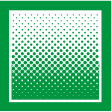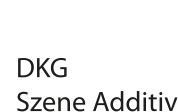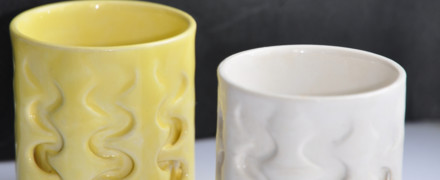
LSD Powder Bed Fusion
LSD based Selective Laser Sintering
Figure 1. illustrates the basic concept of the laser based LSD process. A unique feature of the LSD process is the generation of powder layers revealing a density comparable to a conventional powder compact prepared by slip casting. Most crucial appears in combination with laser sintering the complete drying of deposited layers. Residual solvents can result in a violent vapor formation during laser processing, which, in turn, can destroy the structure treated by the laser. For water based slurries it has been demonstrated that drying can be achieved in less than 10 seconds. Desiccation of a freshly deposited layer is associated to two major mechanisms: First, during and directly after deposition of a layer the solvent is drawn by capillary forces into the supporting powder compact formed by previously deposited layers and, second, rapid evaporation of the solvent. The first mechanism ensures that a freshly deposited layer loses its liquid phase immediately after deposition. Therefore, the temperature of the supporting dry layers can be kept at a temperature significantly exceeding the boiling point of the solvent.
Fig. 1. Schematic of rapid prototyping process using layer-wise slurry deposition.
For the buildup of 3D structures the process steps layer deposition, drying, and laser sintering are repeated [1]. Typical layer thicknesses are in the order of 100 µm. The width of the layer stack is defined by the width of the doctor blade in use, the length is controlled by the movement of the blade parallel to the supporting surface and, thus, rather flexible. Within the boundaries of the supporting platforms surface area, the blades width and trajectory of movement determine the area of material deposition. The height is simply the sum of all layers deposited. This feature is sometimes helpful when only small amounts of material are available and, the total volume of the powder bed must be reduced at a reasonable ratio between width, length and height of the processing volume.
With a lab equipment layers as large as 600 x 1000 mm have been deposited with a thickness of 100 µm. Naturally, drying of layers spread over large areas takes the same time than layers spread on smaller areas. The processing of these large areas by laser sintering, however, requires processing times up to 10 min or even more, depending on the total area to be sintered. This is one of the major disadvantages of selective laser sintering technologies compared to 3D printing. In 3D printing numerous parallel working jets of the print head can process large surface areas much faster, than a single laser spot scanned sequentially over the substrates surface. In the SLS process, the size of the area to be sintered directly correlates to the time the laser needs to process this area. Furthermore the complexity of the part provides an additional factor in the equation of the processing time, as a complex pattern with many small details requires the laser spot to jump from one subarea to the next. Therefore more complex parts do require more time for the laser sintering process.
Bodies generated by layers stacked with the LSD layer stacking technology, but without laser sintering are basically powder compacts showing no obvious texturing or anisotropy originating from the layer deposition process. Also after sintering no anisotropy could be recognized. As conventional slurry systems without additional binder or dispersant can be used, the properties of the powder compact regarding density and mechanical strength are comparable to powder compacts formed by conventional slip casting. This, in turn, gives rise to a unique feature of the LSD process, that is, layers can be stacked without any supporting structure. A first layer is spread directly on the supporting platform and following layers successively building up a free standing block of material in which the three dimensional structure, generated by the laser sintering process, is embedded. Furthermore, due to the mechanical strength of the powder compact, supporting structures within the selective laser sintering process, typically required for fixation of the sintered bodies in a loose powder bed, are not needed, irrespective of the complexity of the part to be buildup.
In case of processes using loose powders the laser sintered body is easily released from the powder bed, but not in the LSD process. After the deposition of all layers required for building up the desired geometry, the laser sintered body is embedded in a powder compact. The powder compact must be dissolved in a solvent. In case of water based slurries, water can act as a solvent for the powder compact. For this task, the powder compact with embedded laser sintered body is placed in a pool of water. Volumes of the powder compact completely encapsulated by sintered material cannot be dissolved and separated from the sintered body [2].
Figure 2. Release of a WC model made of porcelain by employing the LSD technology.
In figure 2 a sequence of photographs taken during the release of a model WC made by the LSD process is shown. The model is formed by 800 layers with a thickness of 100 µm each. The part was generated by using conventional porcelain slurry in a fully automatic rapid prototyping machine, in which all the LSD-based process steps are integrated. This machine (LSD 100) was jointly developed by CIC (Ceramic Institute Clausthal GmbH, Clausthal-Zellerfeld, Germany) and T&T (Tools and Technologies GmbH, Schönwald, Germany). In the machine a worktable with a kinematic resolution, 1 µm/step for vertical (lower the part for each layer) and horizontal motion (realize the slurry deposition), is used to achieve the slurry multi-layer deposition process. The slurry is supplied by a dispenser pump (Dispenser 3NDP8, Netzsch, Germany) and deposited via a doctor blade on a heated (up to 200 ◦C) tile. A 100 W IPG single mode YAG-fiber laser system (wave length 1.064 m, Burbach, Germany) and a galvano-scanner (Hurryscan, Scanlab AG, Germany) are utilized to sinter the dried ceramic layer. The focused laser beam has a spot size of 50 µm. The scanner is controlled by software in which the geometry model is sliced into many layers and each layer is hatched in the respective cross section according to the preset parameters. Repeating the deposition and laser sintering process builds up the final component. Finally the entire block of laser sintered and unsintered powder is placed into water for removing the unsintered material.
It is found that the properties of samples generated by the LSD process are not comparable to conventionally fired samples. In order to improve the properties of laser sintered ceramic parts it is important to understand how the laser light is interacting with ceramic powders. According to figure 3 the laser generates a hot spot on the samples surface by the dissipation of radiation energy into heat. From the hot spot the heat is transferred via heat conduction through the material. Hence, the surface near region of the irradiated area reaches the highest temperatures and densification of the powder by sintering or the formation of a liquid phase is highest. Deeper layers are revealing partially sintered powder or material not affected by the laser treatment. As a result, the laser sintered part appears textures. After an additional post sintering step in a conventional furnace, porcelain ceramics with a density of almost 90 % theoretical density could be reached.
Figure 3. Schematic showing a laser beam interacting with a ceramic powder.
Materials
With the following material parts have been manufactures successfully. Please consider, that parts after laser sintering are not ready to use, but need a post sintering:
Fine Fire Clay
VC / Porcelain
SiC
Literature
- 1 T. Mühler, C. Gomes, ME Ascheri, D. Nicolaides, J.G. Heinrich, J. Günster, "Slurry-Based Powder Beds for the Selective Laser Sintering of Silicate Ceramics", J. of Ceramic Science and Technology 6 [2] 113-117 (2015).
- 2 Thomas Muehler, Juergen Heinrich, Cynthia M. Gomes and Jens Günster, "Slurry-based Additive Manufacturing of Ceramics", Int. J. Appl. Ceram. Technol., 12 [1] 18-25 (2015).
-
 Webmeeting / Webkonferenz | May 02 - May 2, 2022
Webmeeting / Webkonferenz | May 02 - May 2, 2022
AKK-Frühjahrstagung 2022 -
 Ausschuss / Arbeitskreis | Jun 14
Ausschuss / Arbeitskreis | Jun 14
2. Mitgliederversammlung des Anwenderkreises Keramische Additive Fertigung in der DKG (AKF) -
 Webmeeting / Webkonferenz | Jun 17
Webmeeting / Webkonferenz | Jun 17
DKG-Hauptversammlung 2022 -
 Webmeeting / Webkonferenz | Jun 17
Webmeeting / Webkonferenz | Jun 17
FDKG-Hauptversammlung 2022 mit Vorstandswahl (Wahlperiode 2022-24)


